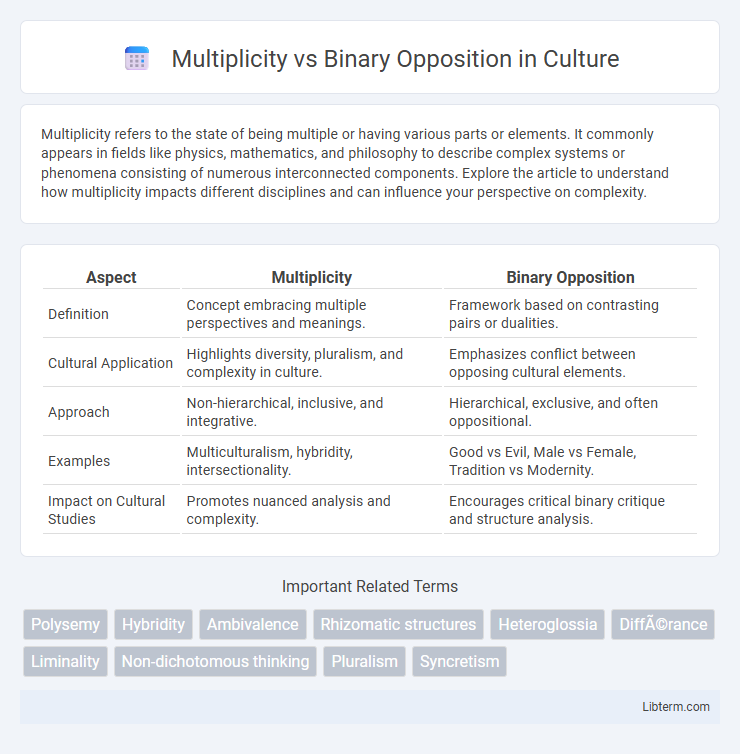Multiplicity refers to the state of being multiple or having various parts or elements. It commonly appears in fields like physics, mathematics, and philosophy to describe complex systems or phenomena consisting of numerous interconnected components. Explore the article to understand how multiplicity impacts different disciplines and can influence your perspective on complexity.
Table of Comparison
| Aspect | Multiplicity | Binary Opposition |
|---|---|---|
| Definition | Concept embracing multiple perspectives and meanings. | Framework based on contrasting pairs or dualities. |
| Cultural Application | Highlights diversity, pluralism, and complexity in culture. | Emphasizes conflict between opposing cultural elements. |
| Approach | Non-hierarchical, inclusive, and integrative. | Hierarchical, exclusive, and often oppositional. |
| Examples | Multiculturalism, hybridity, intersectionality. | Good vs Evil, Male vs Female, Tradition vs Modernity. |
| Impact on Cultural Studies | Promotes nuanced analysis and complexity. | Encourages critical binary critique and structure analysis. |
Understanding Multiplicity: A Conceptual Overview
Multiplicity emphasizes the coexistence of diverse perspectives, identities, or realities without forcing them into hierarchical binaries. It challenges binary opposition by recognizing complexity, fluidity, and interconnectedness in social, cultural, and philosophical contexts. Understanding multiplicity involves acknowledging nuanced differences and embracing pluralism rather than simplistic dichotomies.
Defining Binary Opposition in Theory
Binary opposition is a fundamental concept in structuralist theory that defines meaning through the contrast of two mutually exclusive terms, such as good/evil or light/dark. It operates on the premise that cultural narratives and language are structured around pairs of opposing concepts, which create a clear framework for understanding and interpretation. This dichotomous thinking often simplifies complex phenomena by reducing them to dualistic categories, influencing fields like linguistics, anthropology, and literary theory.
Historical Roots: Multiplicity and Binary Thinking
Binary opposition, rooted in structuralist linguistics by Ferdinand de Saussure, frames meaning through pairs of contrasting concepts such as good/evil or light/ddark, shaping Western philosophical and cultural thought since the 20th century. Multiplicity, influenced by post-structuralist thinkers like Gilles Deleuze, challenges binary frameworks by advocating for diverse, overlapping identities and realities that resist simplistic dualities. Historical roots show binary opposition dominating traditional epistemologies, while multiplicity emerges as a critical response promoting complexity and plurality in understanding knowledge and experience.
Core Differences Between Multiplicity and Binary Opposition
Multiplicity embraces a spectrum of perspectives and identities, reflecting complex realities that resist simple categorization, while binary opposition strictly divides concepts into two mutually exclusive and contradictory categories. Multiplicity allows for overlapping, fluid, and dynamic relationships among elements, whereas binary opposition enforces a rigid dualistic framework that frames meaning through opposing pairs such as good/evil or male/female. This fundamental difference highlights multiplicity's capacity for inclusivity and nuance, contrasting with binary opposition's reliance on clear-cut, polarized distinctions.
The Influence of Multiplicity on Modern Discourse
Multiplicity reshapes modern discourse by challenging the rigid structures imposed by binary opposition, fostering more nuanced understanding of identity and experience. This paradigm encourages recognition of diverse perspectives, breaking down dichotomous thinking that limits critical analysis and inclusivity. As contemporary conversations embrace multiplicity, they reflect complex social realities and promote fluidity in cultural and ideological frameworks.
Binary Opposition’s Role in Cultural Narratives
Binary opposition plays a crucial role in cultural narratives by structuring meaning through contrasting pairs such as good versus evil, male versus female, and light versus dark. This framework simplifies complex social and moral concepts, enabling audiences to navigate cultural values and ideologies easily. Its persistent use in literature, film, and mythology underscores how societies communicate norms and conflicts by emphasizing dichotomous relationships.
Multiplicity in Identity and Representation
Multiplicity in identity and representation emphasizes fluidity, intersectionality, and the coexistence of diverse attributes within individuals or groups, challenging fixed or singular categorizations inherent in binary opposition frameworks. This approach recognizes identities as complex, dynamic constructs shaped by overlapping cultural, social, and personal factors rather than mutually exclusive binaries such as male/female or us/them. Embracing multiplicity enhances inclusivity and accuracy in representing lived experiences, promoting richer, more nuanced understandings of identity beyond binary constraints.
Challenges of Binary Opposition in Contemporary Society
Binary opposition in contemporary society often oversimplifies complex identities and experiences by forcing individuals into rigid, mutually exclusive categories, such as good versus evil or us versus them. This oversimplification disregards the fluidity and intersectionality inherent in personal and social identities, leading to marginalization and misunderstanding of diverse perspectives. The challenge lies in moving beyond binary frameworks to embrace multiplicity, which recognizes the coexistence of multiple, overlapping, and evolving identities and realities.
The Shift from Dualities to Multiplicities
The shift from binary opposition to multiplicity in critical theory emphasizes moving beyond rigid dualistic frameworks--such as good versus evil or black versus white--toward recognizing complex, interrelated identities and perspectives. Multiplicity allows for a more nuanced understanding of cultural, social, and literary phenomena by highlighting diversity, fluidity, and the coexistence of multiple truths. This approach challenges reductionist thinking and promotes inclusive analysis by acknowledging the simultaneous presence of contrasting and overlapping elements within a single context.
Embracing Multiplicity: Future Perspectives and Implications
Embracing multiplicity challenges the limitations of binary opposition by promoting diverse viewpoints and complex identities in cultural, social, and philosophical contexts. This shift encourages inclusive frameworks that recognize fluidity and intersectionality, fostering innovation and adaptability in addressing contemporary global issues. Future perspectives emphasize the importance of multiplicity in driving equitable policies, enriching dialogue, and supporting dynamic systems beyond rigid dichotomies.
Multiplicity Infographic

 libterm.com
libterm.com